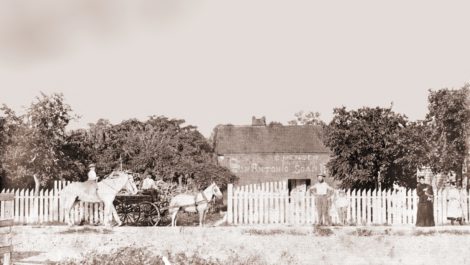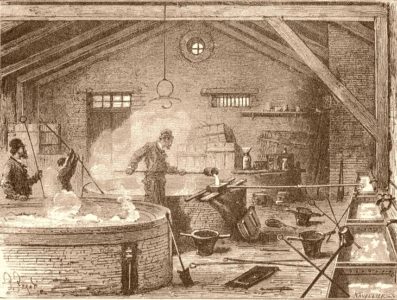Early Industry Along San Pedro Creek
Audio Tour
Audio Guía
Image Gallery
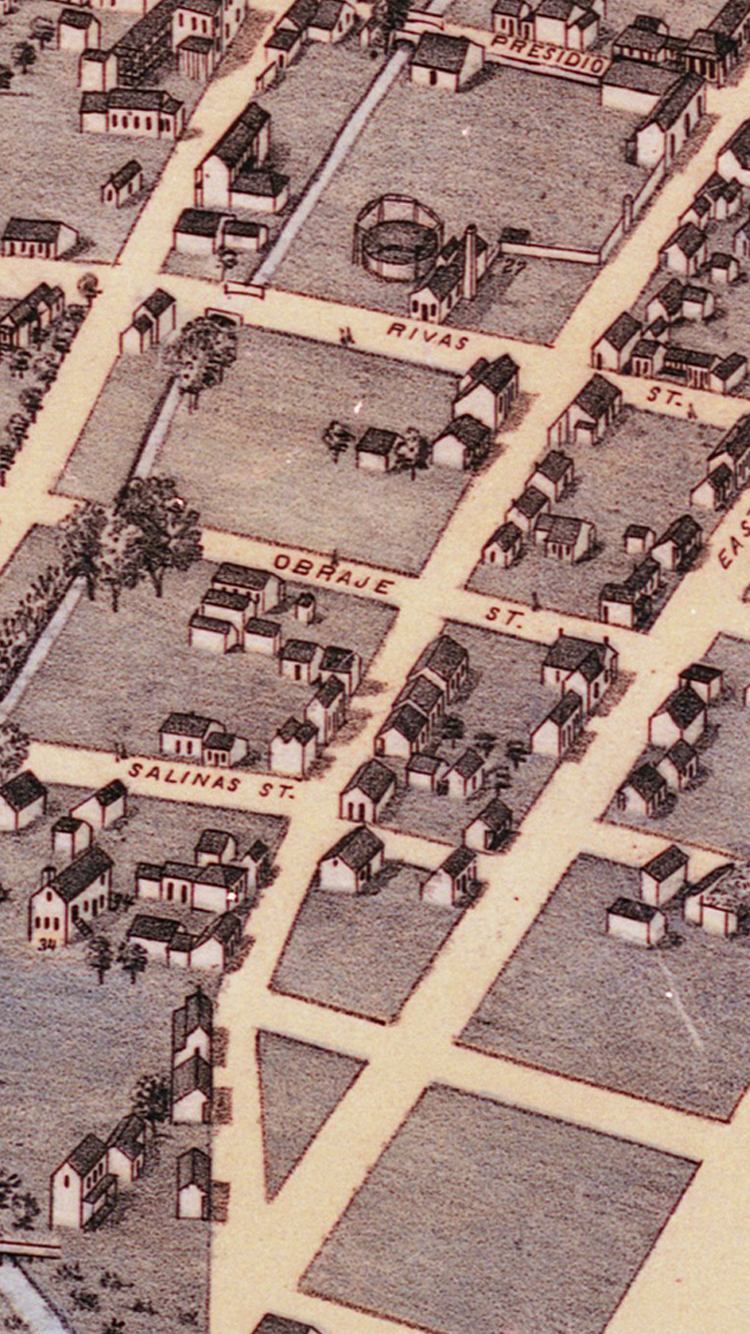
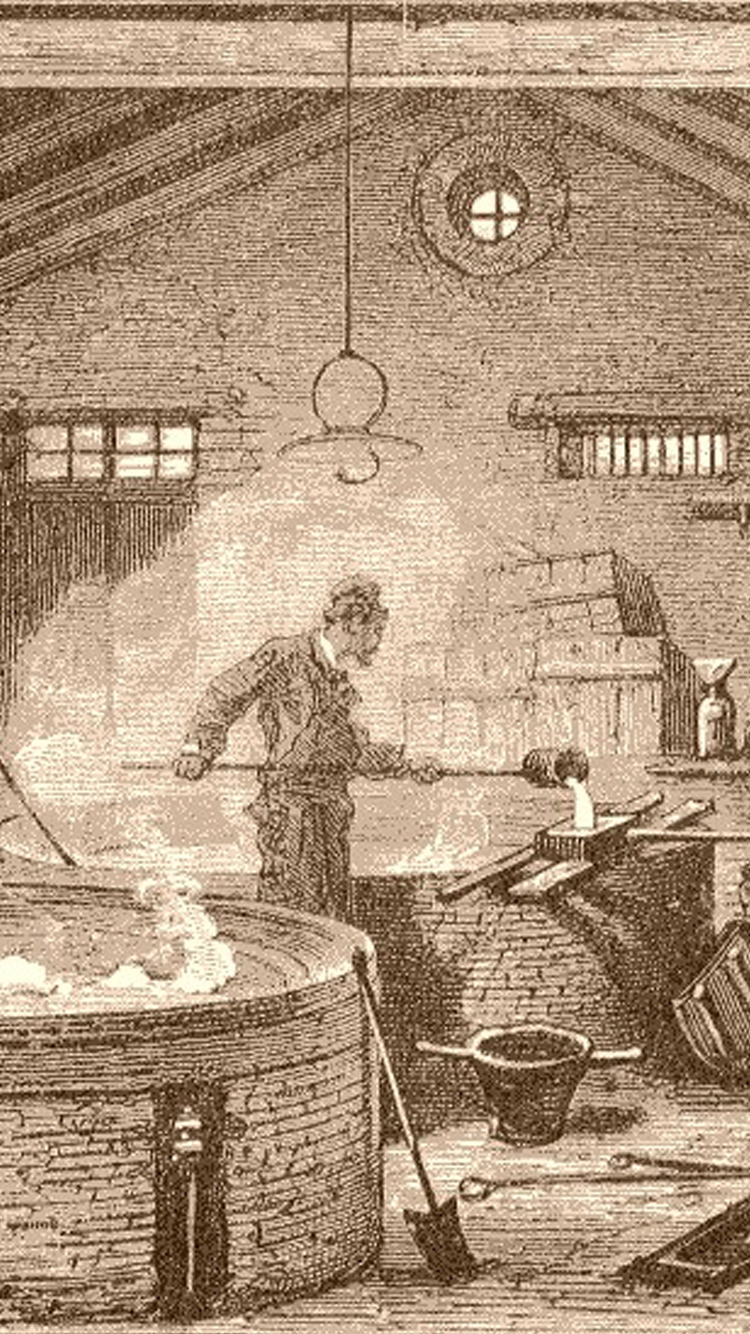
English
Español
-
These ancient waters also served as a resource for San Antonio’s first entrepreneurs and aspiring industrialists.
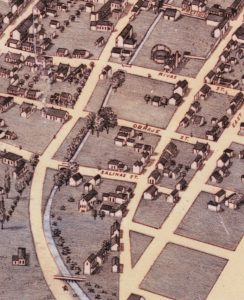
Source: “Bird’s Eye View of the City of San Antonio, Bexar County, Texas. 1873.” San Pedro Creek was an invaluable source of water for residents who lived and farmed and grazed their livestock along its banks. The creek also provided water for businesses that manufactured a variety of products for the local market. The ingenious German immigrant Simon Menger, a music teacher by profession, purchased a soap-making business on the creek south of this site in 1851. He expanded the facility and advertised himself as a “manufacturer of soap, tallow candles and vinegar.” After his factory was badly damaged by a flood in 1859, Menger began purchasing property further upstream and reestablished his business here on the west bank of San Pedro Creek. Simon and Augusta Louise Menger raised their family in the home they built adjoining the factory. S. Menger and Sons, later known as the San Antonio Soap Works, manufactured products for household and commercial uses and by the late 1870s sold over 25,000 pounds of soap per month.
As their father grew older, Erich Menger managed the San Antonio business and August oversaw a branch factory in Houston. Erich purchased the soap works in 1882 and continued operating the business here until the early 1900s. The building was later used as a broom factory, printing shop, and apartments. Like other landmarks of early city history, the soap works was abandoned to decades of disuse. After surviving years of neglect, it was eventually threatened with demolition by the Urban Renewal program, only to be saved by the San Antonio Conservation Society in 1970. This historic structure, San Antonio’s earliest remaining industrial building, was restored and incorporated into the nearby Soap Works Apartment complex. Part of the creek’s long history lives within its walls.
Audio Tour
As you look out onto the creek, try to imagine it in its natural form. There are bison and even now-extinct saber-toothed cats roaming about. The native Payaya people lived here in peace among the natural habitat. Fast forward to the early days of Spanish settlement, new missions established, and the beginnings of a city. Further now, to the 1800s. It was still a humble creek, but the locals began to see the potential of the historic waters as a hub for business. Entrepreneurial spirits grasped their opportunity to have a piece of the pie. Among the most notable business of the day was the San Antonio Soap Works, purchased by German immigrant and music teacher Simon Menger. His first building was badly damaged by a flood in 1859, but that didn’t stop him. He began purchasing property further upstream and reestablished his business right here on the west bank of San Pedro Creek. By the late 1870s, Menger was selling more than 25,000 pounds of soap per month. Simon and his wife Augusta Louise raised their family in a home connected to the works, and when Simon retired, his sons followed in their father’s footsteps, even opening a branch factory in Houston. The Menger family operated their soap business until the early 1900s, and since, it has been the home of a broom factory and printing shop. Thanks to the San Antonio Conservation Society, the building was saved from demolition in 1970. It has been restored and incorporated into the nearby Soap Works apartment complex, alive and well to tell its story of early industry along San Pedro Creek.Simon Menger’s soap works and surrounding buildings on the west bank of San Pedro Creek were illustrated by Augustus Koch in 1873.
-
Estas aguas antiguas también fueron un recurso para los primeros empresarios y aspirantes de la industria en San Antonio.

Source: “Bird’s Eye View of the City of San Antonio, Bexar County, Texas. 1873.” El Arroyo San Pedro era una fuente de agua invaluable para los residentes que vivían, cultivaban y alimentaban su ganado a lo largo de sus orillas. El arroyo también proporcionó agua para las empresas que fabricaban una amplia variedad de productos para el mercado local. En 1851, el ingenioso inmigrante alemán Simon Menger, profesor de música de profesión, compró un negocio de fabricación de jabón localizado en el arroyo, al sur de este sitio. Expandió las instalaciones y se hizo publicidad a sí mismo como un “fabricante de jabón, velas de sebo y vinagre”. Después de que su fábrica resultara gravemente dañada por una inundación en 1859, Menger comenzó a comprar propiedades aguas arriba y estableció su nuevo negocio aquí, en la ribera occidental del Arroyo San Pedro. Simon y Augusta Louise Menger criaron a su familia en la casa que construyeron contigua a la fábrica. S. Menger and Sons, más tarde conocida como San Antonio Soap Works, fabricaba productos para uso doméstico y comercial y para fines de la década de 1870, vendía más de 25,000 libras de jabón por mes.
A medida que su padre iba envejeciendo, Erich Menger administró el negocio de San Antonio y August supervisó una segunda fábrica en Houston. Erich compró las fábricas de jabón en 1882 y continuó operando el negocio hasta principios del siglo XX. El edificio fue utilizado más tarde como una fábrica de escobas, imprenta y apartamentos. Al igual que otros edificios emblemáticos de la historia temprana de la ciudad, las fábricas de jabón fueron abandonadas y sufrieron décadas de abandono. Después de sobrevivir años de negligencia, fueron eventualmente amenazadas con la demolición por el programa de Renovación Urbana, solo para ser salvadas por la Sociedad de Conservación de San Antonio en 1970. Esta estructura histórica, el primer edificio industrial de San Antonio que sobrevive, fue restaurada e incorporada al cercano complejo de apartamentos Soap Works. Parte de la larga historia del arroyo vive dentro de sus muros.
Audio Guía
Mientras usted mira hacia el arroyo, trate de imaginarlo en su forma natural. Hay búfalos y tigres dientes de sable, ahora extintos, vagando libremente. Los nativos Payaya vivieron aquí en paz, en el hábitat natural. Avance rápido a los primeros días del asentamiento español, se establecen nuevas misiones, y son los comienzos de una ciudad. Avance más, hasta el 1800. Todavía era un arroyo humilde, pero los lugareños empezaron a ver el potencial de las aguas históricas como un centro de negocios. Los espíritus emprendedores aprovecharon esta oportunidad para dar marcha a sus planes. Entre los negocios más notables del día se encontraba la fábrica de jabón San Antonio Soap Works, comprada por el inmigrante alemán y profesor de música Simon Menger. Su primer edificio fue gravemente dañado por una inundación en 1859, pero eso no lo detuvo. Comenzó a comprar propiedades agua arriba y reestableció su negocio aquí mismo en la ribera occidental del Arroyo San Pedro. A finales de 1870, Menger vendía más de 25,000 libras de jabón al mes. Simón y su esposa Augusta Louise criaron a su familia en un hogar conectado a la fábrica, y cuando Simón se jubiló, sus hijos siguieron los pasos de su padre, incluso abrieron una sucursal de la fábrica en Houston, TX. La familia Menger operó su negocio de jabones hasta principios de 1900, y desde entonces, ha sido la sede de una fábrica de escobas y taller de impresión. Gracias a la Sociedad de Conservación de San Antonio, el edificio fue salvado de su demolición en 1970. Ha sido restaurado e incorporado al cercano complejo de apartamentos Soap Works, sano y salvo para narrar su historia de la industria incipiente a lo largo del Arroyo San Pedro.Las fábricas de jabón de Simon Menger y los edificios circundantes en la orilla oeste del Arroyo San Pedro fueron ilustradas por Augustus Koch en 1873. En esta vista, el norte está en la parte inferior.

